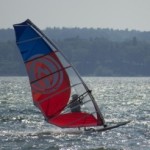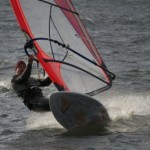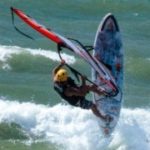Home Page › Discussion Forum › General Windsports Discussion › Getting Your Sail and Board "Dialed-In"
- This topic has 4 replies, 3 voices, and was last updated 4 years, 6 months ago by
 Geoff.
Geoff.
-
AuthorPosts
-
-
October 9, 2019 at 8:16 pm #7615
 GeoffParticipant
GeoffParticipantEric asked a question about whether my new sail is back handy, because it’s a squat / fat design. Rather than answer that directly, I thought I’d post my (likely different) thoughts on how to set up your board and rig.
First, I’ll say that a long time ago, I took a buttload of 3- and 5-day Cort Larned clinics, which taught me a lot and got me into rigging big. I still gybe better when I’m massively overpowered. Cort called me the master of the “Houdini gybe”, because he used video of the students in the clinic and, when reviewing them, I had a knack of getting so far out of proper position that it was a certain crash….only to sail away somehow, like Houdini in his escape artist tricks. If you don’t know who Houdini was, well, Google him. There are some great old flicks about Houdini.
Subsequently I went to some Andy Brandt freestyle clinics in Bonaire, and must say that I had to re-learn almost everything. Fortunately, Houdini survived, but what I learned from Andy was the magic that comes when you master the art of luffing the sail. Maybe more on that in a separate thread.
But by far, the most valuable thing I ever learned was from a video by Brad Duffy (former world speed sailor record holder) called “The University of Speed”. It’s long out of print, can’t find anything of it on the web. But the folks who have it have a gem.
Bottom line from this film is that if you want to go fast, you must learn how to balance up all the elements of your rig. Also, if you want to make a high percentage of gybes, you must have everything balanced. The reason for this is that for every action, there is an equal and opposite reaction. And if you’re pushing or pulling on something (most commonly back hand, back foot), then you’re causing drag and that won’t be fast. For the sail (and fin) to slice through the air (water), you want little pressure on the back hand/foot. Otherwise, you have a steep angle of attack and are creating both frontal area drag and tip vortex drag. And then when it comes to initiating a gybe, you are a little out of balance, pulling with one hand, pushing with matching foot, so that when you initiate (oversheeting to depower the sail) you end up not just letting go but also having to un-compensate for being out of balance. This makes it MUCH harder to complete the gybe than when you enter nicely balanced and just initiate the turn.
Q: So what is “balanced”?
A: Equal pressures on the front foot/hand and back foot/hand.
Because of the equal-and-opposite forces rule of physics, if you’re pushing on the front hand, you’ll have to pull with the front foot, and (more often) if you’re pulling on the back hand, you’ll have to push on the back foot. There are times / setups / conditions where you want to do that, but not if you seek balance, speed, and ease of maneuvering. The easiest maneuvering comes when you have equal pressures on the front and back feet, which (by virtue of the equal-and-opposite rule) requires equal pressures on the front and back hands.
So if we want to go upwind or downwind easily, and equally, then what we need is balanced pressures on a beam reach. Then it’s front foot pulling, back foot pushing to go upwind, and the opposite to go downwind (and pushing on the front hand and pulling on the back to go upwind, pulling on the front hand and pushing – or letting out – on the back hand). In windsurfing, we’re never pulling or pushing with both hands, it’s always pulling with one, pushing with the other, and by the laws of physics your feet are doing the opposite.
Thus, in my view, if a sail is “back handy”, the sail, board and fin are not balanced. You might want to sail it that way, but by definition the setup is not in balance. To go fast and easy and in control through chop, you’ve got to be balanced. So how do you get there?
Duffy had a really nice set of drills to teach you how to find balance. Do this, and I promise it will transform your sailing – you’ll be able to get where you want to go, and you’ll make a lot more gybes.
1) Lower the boom to the bottom of the cutout. Center the harness lines so that, when fully powered up, you can transiently let go of the boom and the harness keeps the sail in balance (i.e., the harness lines are equidistant from the CoE of the sail). Go out in this configuration; you’ll have massive front foot pressure and find it hard to keep the board from going upwind.
2) Come back to the beach, and raise the boom a little. You shouldn’t have to change the harness lines. Go out in this configuration; the front foot pressure will be less than it was.
3) Do it again, and again, coming in until you have the boom at the top of the cutout. Each time, when you go out sailing, the pressure on the front foot will diminish and the back foot will increase. With the boom at the top of the cutout, the back foot pressure will be really high and you’ll spin out a lot.
4) What you want to find is the boom height where there is equal back foot and front foot pressure. In most modern boards, this will be with the boom something like 1-3″ off the tail of the board.
5) Now you need to find the sweet spot for the mast base, because moving the mast base fore and aft changes the alignment of the sail -vs- fin CoE.
6) Run the mast base all the way forward, which will make the boom height you’ve got too low, so you’ll have increased front foot pressure again.
7) Do the same thing with the mast base that you did with the boom height, to find the mast base position that balances up the pressure on hands/feet.
8) Fine tune the mast base, boom height and harness line positions so that you find the position where hand and feet pressures are balanced. Vóila!
9) N.B.: If you change fins, it’s likely to change the balance because fins have different CoE’s and they won’t handle the same. So now you know how to match your board, sail and fin!
This may seem like a lot of work, but it doesn’t take very long to find the optimal settings. 20-30 minutes, max. And once you have it, you can use a Sharpie to write on each sail what the optimal settings are. This is really a valuable skill, and it’s too bad that clinics don’t spend much time on this and that Brad Duffy’s video seems to be a long-lost relic of the 90s.
On all the modern boards I’ve ridden, they seem to have a single mast base position where the board has an optimal nose-up attitude on the water. Too far forward it’s too low, too far back it’s too high. On old-skool boards (pre-1993), the mast base needed to be moved forward for big sails and aft for smaller sails, but not in my experience with any modern boards.
There are times when you might want your kit to be back-handy, such as when you want to go jumping. And you might want your boom to be high, such as in freestyle or wave riding where you want to hang down on the boom so that the mast base pressure keeps the board flat on the water so you can better steer with your front foot.
Spend half-an-hour going through Duffy’s drill, getting a feel for how adjusting all the pieces of your kit changes the handling. Because once you know that, when things aren’t going well some day, you can go back to making your setup neutral, balanced and fast. You’ll be surprised how often this fix will get you back to being dialed-in and transform a difficult day into a great session.
Next time, we’ll discuss Andy Brandt’s “Sail Chi”.
-
October 11, 2019 at 8:43 am #7616
 ScottParticipant
ScottParticipantGeoff, this is great stuff! Very valuable information. I could read this technical windsurfing tuning stuff all day long. Hope you write more for us.
I’ve read most of Eric’s technical articles on his blog and found it very helpful. I have been playing with my boom height adjustments this year and can relate to your observations. Thanks!
-
October 11, 2019 at 10:13 pm #7617
 GeoffParticipant
GeoffParticipantFor a guy who likes blasting like you do, Scott, the tips of Brad Duffy are priceless. In my experience, you’ll go a lot faster with less effort and make many more gybes. Hope you find this thread helpful.
I’ll have to think about the best way to describe Andy Brandt’s sail chi. If you haven’t been taught this conceptual model of sailing, it’s sort-of Monty Python-esque in the “And now for something completely different…” way. I spent a year unlearning almost everything I learned from Cort Larned before I really started getting it. But if you want to sail until you’re 85 (yes!), sail chi is what you need to know most of all.
And, hopefully, Hot Sails Maui will be still making Freaks when I get there, because old bones and shoulders like soft sails. And if I were pressed on advice, I’d suggest switching to soft transitioning sails before you have to, lest those hard POP!s make you have to go to soft sails.
-
October 13, 2019 at 10:25 am #7618
 mihelbergelParticipant
mihelbergelParticipantFANTASTIC post!!!! Love it! Thanks so much Geoff. I’m going to come back and read it several more times.
-
October 13, 2019 at 7:52 pm #7619
 GeoffParticipant
GeoffParticipantI’m just reporting what I learned from Brad Duffy. Knowing how to systematically adjust your boom height, mast base position, harness line center point, foot straps and fin so that you have them all balanced up and can sail relaxed and effortlessly is an extraordinarily important skill, and I haven’t seen anyone else teach it. In the Cort Larned clinics, we got a little bit of that because some of us were whining about it, but nothing as thorough and systematic as what Duffy said in his video.
Seriously, if you can find a copy of that videotape, you should buy it. It’ll be one of the most helpful instructional videos about windsurfing that you’ll ever see.
University of Speed
-
-
AuthorPosts
- You must be logged in to reply to this topic.
